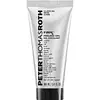What's inside
What's inside
 Key Ingredients
Key Ingredients

 Benefits
Benefits

 Concerns
Concerns

 Ingredients Side-by-side
Ingredients Side-by-side

Water
Skin ConditioningCamellia Sinensis Leaf Water
MaskingGlycerin
HumectantCellulose
AbsorbentButylene Glycol
HumectantSodium Hyaluronate
HumectantDipotassium Glycyrrhizate
HumectantCetyl Ethylhexanoate
EmollientBetaine
HumectantBeta-Glucan
Skin ConditioningArginine
MaskingAnthemis Nobilis Flower Extract
MaskingAllantoin
Skin ConditioningSodium Polyglutamate
HumectantCarbomer
Emulsion Stabilising1,2-Hexanediol
Skin ConditioningCaprylyl Glycol
EmollientSodium Hydroxide
BufferingLavandula Angustifolia Oil
MaskingWater, Camellia Sinensis Leaf Water, Glycerin, Cellulose, Butylene Glycol, Sodium Hyaluronate, Dipotassium Glycyrrhizate, Cetyl Ethylhexanoate, Betaine, Beta-Glucan, Arginine, Anthemis Nobilis Flower Extract, Allantoin, Sodium Polyglutamate, Carbomer, 1,2-Hexanediol, Caprylyl Glycol, Sodium Hydroxide, Lavandula Angustifolia Oil
Water
Skin ConditioningPEG-32
HumectantCellulose
AbsorbentButylene Glycol
HumectantCitrus Aurantium Bergamia Fruit Water
Skin ConditioningSorbitol
HumectantR-Bacillus Licheniformis Keratinase
Skin ConditioningAnanas Sativus Fruit Extract
Skin ConditioningLactobacillus/Punica Granatum Fruit Ferment Extract
Skin ConditioningLeuconostoc/Radish Root Ferment Filtrate
AntimicrobialSodium Hyaluronate
HumectantGlycerin
HumectantSodium Hydroxide
BufferingCitric Acid
BufferingTetrasodium EDTA
Algin
MaskingCarbomer
Emulsion StabilisingTromethamine
BufferingIsopropyl Myristate
EmollientSodium Chloride
MaskingCalcium Chloride
AstringentPotassium Sorbate
PreservativeSodium Benzoate
MaskingMica
Cosmetic ColorantPhenoxyethanol
PreservativeWater, PEG-32, Cellulose, Butylene Glycol, Citrus Aurantium Bergamia Fruit Water, Sorbitol, R-Bacillus Licheniformis Keratinase, Ananas Sativus Fruit Extract, Lactobacillus/Punica Granatum Fruit Ferment Extract, Leuconostoc/Radish Root Ferment Filtrate, Sodium Hyaluronate, Glycerin, Sodium Hydroxide, Citric Acid, Tetrasodium EDTA, Algin, Carbomer, Tromethamine, Isopropyl Myristate, Sodium Chloride, Calcium Chloride, Potassium Sorbate, Sodium Benzoate, Mica, Phenoxyethanol
Ingredients Explained
These ingredients are found in both products.
Ingredients higher up in an ingredient list are typically present in a larger amount.
Butylene Glycol (or BG) is used within cosmetic products for a few different reasons:
Overall, Butylene Glycol is a safe and well-rounded ingredient that works well with other ingredients.
Though this ingredient works well with most skin types, some people with sensitive skin may experience a reaction such as allergic rashes, closed comedones, or itchiness.
Learn more about Butylene GlycolCarbomer is a polymer of acrylic acid. Its main role is to create a gel consistency.
A high amount of carbomer can cause pilling or balling up of products. Don't worry, most products contain 1% or less of carbomer.
Cellulose is the main component of plant cell walls. It is used as an emulsifier, absorbent, and texture enhancer.
This ingredient has many functions:
Fun fact: Cellulose is the most abundant form of organic polymer on Earth.
Learn more about CelluloseGlycerin is already naturally found in your skin. It helps moisturize and protect your skin.
A study from 2016 found glycerin to be more effective as a humectant than AHAs and hyaluronic acid.
As a humectant, it helps the skin stay hydrated by pulling moisture to your skin. The low molecular weight of glycerin allows it to pull moisture into the deeper layers of your skin.
Hydrated skin improves your skin barrier; Your skin barrier helps protect against irritants and bacteria.
Glycerin has also been found to have antimicrobial and antiviral properties. Due to these properties, glycerin is often used in wound and burn treatments.
In cosmetics, glycerin is usually derived from plants such as soybean or palm. However, it can also be sourced from animals, such as tallow or animal fat.
This ingredient is organic, colorless, odorless, and non-toxic.
Glycerin is the name for this ingredient in American English. British English uses Glycerol/Glycerine.
Learn more about GlycerinSodium Hyaluronate is hyaluronic acid's salt form. It is commonly derived from the sodium salt of hyaluronic acid.
Like hyaluronic acid, it is great at holding water and acts as a humectant. This makes it a great skin hydrating ingredient.
Sodium Hyaluronate is naturally occurring in our bodies and is mostly found in eye fluid and joints.
These are some other common types of Hyaluronic Acid:
Learn more about Sodium HyaluronateSodium Hydroxide is also known as lye or caustic soda. It is used to adjust the pH of products; many ingredients require a specific pH to be effective.
In small amounts, sodium hydroxide is considered safe to use. However, large amounts may cause chemical burns due to its high alkaline.
Your skin has a natural pH and acid mantle. This acid mantle helps prevent harmful bacteria from breaking through. The acid mantle also helps keep your skin hydrated.
"Alkaline" refers to a high pH level. A low pH level would be considered acidic.
Learn more about Sodium HydroxideWater. It's the most common cosmetic ingredient of all. You'll usually see it at the top of ingredient lists, meaning that it makes up the largest part of the product.
So why is it so popular? Water most often acts as a solvent - this means that it helps dissolve other ingredients into the formulation.
You'll also recognize water as that liquid we all need to stay alive. If you see this, drink a glass of water. Stay hydrated!
Learn more about Water